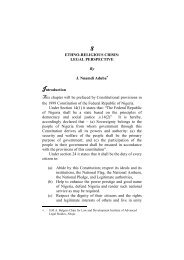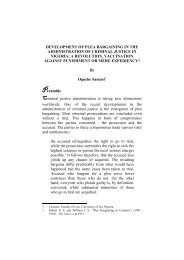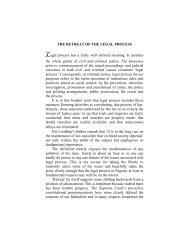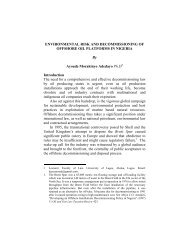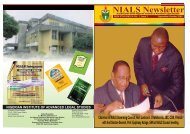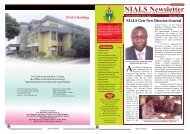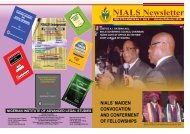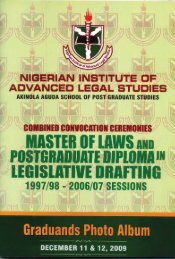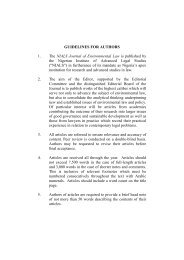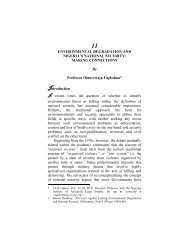9 - The Nigerian Institute of Advanced Legal Studies
9 - The Nigerian Institute of Advanced Legal Studies
9 - The Nigerian Institute of Advanced Legal Studies
Create successful ePaper yourself
Turn your PDF publications into a flip-book with our unique Google optimized e-Paper software.
284<br />
Law and Security in Nigeria<br />
flows. <strong>The</strong>se factors have created opportunities for<br />
militant groups and other private actors to access<br />
sophisticated SALW previously accessible only by<br />
members <strong>of</strong> the armed forces. 96<br />
2) Security Sector Black-racketeering: A large portion<br />
<strong>of</strong> illicit firearms consist <strong>of</strong> leakages from members <strong>of</strong><br />
the armed forces and the police both serving and<br />
retired. This includes the remnants from the <strong>Nigerian</strong><br />
civil war and leakages from returnees <strong>of</strong> peace<br />
keeping operations. 97<br />
3) Local Manufacturing: Nigeria also has a significant<br />
local supply <strong>of</strong> legitimate and illicit SALW through<br />
local manufactures. 98 Section 22 <strong>of</strong> the Firearms Act<br />
prohibits the manufacture <strong>of</strong> firearms. However, the<br />
government established Defence Industries<br />
Corporation <strong>of</strong> Nigeria (DICON) set up in 1964 via<br />
the Defence Industries Corporation <strong>of</strong> Nigeria Act, is<br />
legally empowered to produce arms and ammunitions<br />
in the country mainly for use by the military and the<br />
police. Given the legal status <strong>of</strong> its mandate, this does<br />
not constitute a significant source <strong>of</strong> illicit small arms.<br />
96. Ngang, op cit, pp 21-24; Small Arms Survey, 2001, op cit; Human Rights<br />
Watch, “<strong>The</strong> Warri Crisis: Fuelling Violence”, Human Rights Watch, Vol.<br />
15, no. 18(A), pp 24-25.<br />
97. See Report <strong>of</strong> the PANAFSTRAG and NANSA, op cit. See also Hazen and<br />
Horner, ibid, pp 36-37.<br />
98. See Study by Bako Wali: on “National Arms Production Capacity <strong>of</strong><br />
Nigeria”, 2005, pp 51-53, available at: http://www.uncasa.org/CASACountryPr<strong>of</strong>ile/OtherDocument/61@InvRpt_Nigeria.pdf.<br />
As far back as 1989, DICON’s annual production capacity was as follows:<br />
15, 000 rifles, 9000-10,000 pistols and 1000 machine guns. See “Nigeria:<br />
Arms Procurement and Defence Industries”, Library <strong>of</strong> Congress Country<br />
<strong>Studies</strong>: CIA World Factsheet, June 1991, at:<br />
http://www.photius.com/countries/nigeria/national_security/nigeria_nation<br />
al_security_arms_procurement_and~10039.html.



